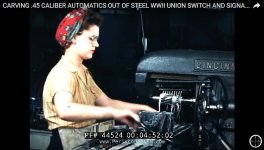Watchdog
Member
- Joined
- Apr 6, 2013
- Messages
- 12,510
- Reaction score
- 32,351
I did a search to make sure I hadn't posted this before, and it didn't show up here, so hopefully this isn't a duplicate post.
This is a short silent film showing how Union Switch & Signal 1911A1s were manufactured at their plant in Swissvale, Pennsylvania.
Only 55,000 US&S 1911A1s were made.
The film is very interesting to me...and just seeing all those beautiful brand spankin' new .45s with that Du-Lite finish is something. What I wouldn't give for just one of them!!
And thinking...some of our mothers or grandmothers made and inspected pistols that were carried by soldiers in the war! I like watching that one lady disassemble the pistol...she doesn't need one of those sissified bushing wrenches, either.
Anyway, if you like the old pistols...enjoy the film.
[ame]https://www.youtube.com/watch?v=Q7XUtgIVo7k[/ame]
This is a short silent film showing how Union Switch & Signal 1911A1s were manufactured at their plant in Swissvale, Pennsylvania.
Only 55,000 US&S 1911A1s were made.
The film is very interesting to me...and just seeing all those beautiful brand spankin' new .45s with that Du-Lite finish is something. What I wouldn't give for just one of them!!
And thinking...some of our mothers or grandmothers made and inspected pistols that were carried by soldiers in the war! I like watching that one lady disassemble the pistol...she doesn't need one of those sissified bushing wrenches, either.
Anyway, if you like the old pistols...enjoy the film.
[ame]https://www.youtube.com/watch?v=Q7XUtgIVo7k[/ame]




